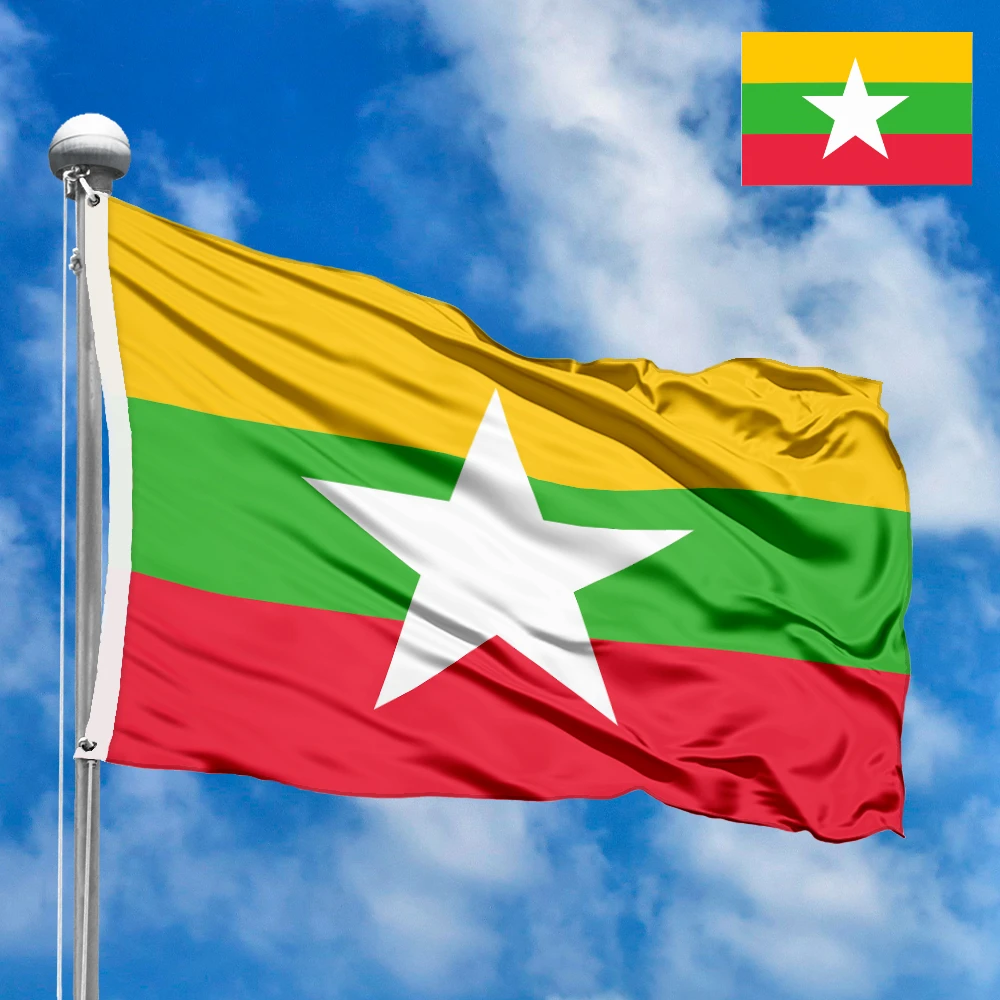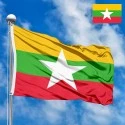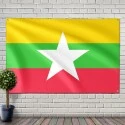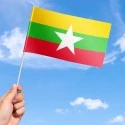The national flag of Myanmar (formerly Burma) is a vibrant and modern symbol that embodies the nation's aspirations for unity, peace, and prosperity. Adopted in 2010, it replaced an older design, marking a significant transition in the country's political landscape and its vision for a new era. This flag tells a story of a diverse nation striving for harmony and a brighter future.
Design and Dimensions
The flag of Myanmar features three horizontal stripes of equal width: yellow on top, green in the middle, and red at the bottom. Superimposed in the center of these stripes is a large, white, five-pointed star. The standard proportions of the flag are typically 2:3 (height to width), giving it a balanced and easily recognizable rectangular shape. The central star is prominently placed, ensuring its visibility as the focal point of the design.
Symbolism of the Colors and Elements
Each color and element on the Myanmar flag carries specific symbolic meaning, reflecting the nation's values and aspirations:
-
Yellow Horizontal Stripe: The top yellow stripe symbolizes solidarity, peace, and wisdom. It represents the unity of all ethnic groups within Myanmar and their shared commitment to a peaceful future. It also signifies the country's aspiration for wisdom in governance and societal harmony.
-
Green Horizontal Stripe: The middle green stripe represents peace, tranquility, and the country's lush, rich natural environment. It symbolizes Myanmar's fertile land, its abundant natural resources, and its commitment to a green and sustainable future. This color also signifies the nation's desire for a peaceful and tranquil existence.
-
Red Horizontal Stripe: The bottom red stripe symbolizes courage, decisiveness, and the strong will of the people of Myanmar. It represents the sacrifices made for the nation's independence and its determination to overcome challenges and build a strong, unified country.
-
White Five-pointed Star: The prominent white star in the center of the flag is the most significant element. It represents the union of the country, symbolizing the unity and integration of all the diverse ethnic groups that make up the nation of Myanmar. The five points traditionally represent the five fingers of a hand, further emphasizing unity and collective strength. Its white color signifies purity and uprightness.
History of Creation and Adoption
The current flag of Myanmar was officially adopted on October 21, 2010, marking a pivotal moment in the country's political evolution. This adoption was part of a series of reforms leading up to the 2010 general election and the dissolution of the military junta. The new flag replaced the former socialist-era flag, which had been in use since 1974.
The previous flag (1974-2010) also featured a red field with a blue canton in the upper hoist corner. Within the blue canton, there was a cogwheel and a rice stalk (representing industry and agriculture), surrounded by 14 white stars (representing the 14 states and regions of Myanmar). The current design represents a break from the socialist iconography and a move towards a more universally understood set of symbols. The new design draws inspiration from the flag used by the State of Burma during the Japanese occupation in World War II (1943-1945), which also featured yellow, green, and red stripes, but with a peacock in the center. The star replaced the peacock, signifying a forward-looking vision of unity.
Significance for the Inhabitants
For the people of Myanmar, the national flag is a powerful emblem of their national identity, unity, and aspirations for a democratic and prosperous future. It symbolizes a new chapter in the nation's history, moving away from a period of military rule and towards a more open and inclusive society. The flag represents the collective hope for peace and stability after decades of internal conflict and political upheaval.
It instills a sense of shared purpose and belonging among the country's diverse ethnic groups, encouraging them to work together for the common good. Displayed during national holidays, public events, and in daily life, the flag serves as a constant reminder of their sovereignty, their resilience, and their collective determination to build a unified and harmonious nation. It is a source of immense pride, reflecting their deep connection to their land and their shared heritage.
Interesting Facts
-
Newer Flag: The current flag of Myanmar is relatively new, having been adopted in 2010, making it one of the younger national flags in the world.
-
Replaced Socialist Emblem: Its adoption marked a significant symbolic break from the socialist military government that had ruled the country for decades.
-
Colors with Pan-African Resonance: While distinct, the combination of yellow, green, and red can also be found in Pan-African flags, although in Myanmar's context, the symbolism is unique to its national aspirations.
-
Symbol of Federalism: The white star centrally placed on the flag emphasizes the desired unity and harmonious integration of Myanmar's diverse ethnic states and regions.
-
Historical Echoes: The color scheme of yellow, green, and red has historical precedents in Burmese flags, notably the flag of the Japanese-backed State of Burma during WWII, showcasing a reinterpretation of earlier national symbols.
In the demonstration images, full-size flags are shown with proportions of 2:3, and hand-held flags with proportions of 1:2.






 Waving flag
Waving flag
 Sizes:
Sizes:
 Round flag
Round flag
 Sizes:
Sizes:
 Rectangular flag 2:3
Rectangular flag 2:3
 Sizes:
Sizes: